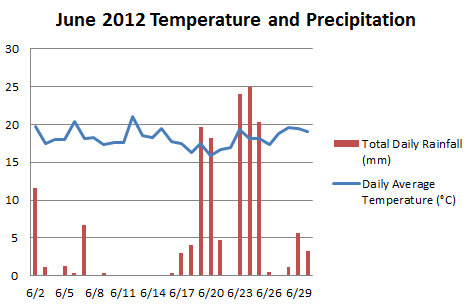June 2012 - Great Global Investigation of Climate
June 2012 GGIC Summary
So far through the GGIC summaries, we've failed to look at one of the variables you, our GLOBE student climate scientists, has been measuring: precipitation.
June of 2012 saw the return of El Nino conditions to the Pacific Basin. El Nino is excess warming of ocean water off the western coast of South America. Many locations across the globe experience different conditions when an El Nino is occurring. For places like Mexcio, they experience wetter conditions. This leaves the question – did GLOBE schools experience this?
Let's take a look at Facultad de Estudios Superiores Cuautitlan in Cuautitlan Izcalli, Mexico, which is north of Mexico City. While this doesn't provide climatological information, it is important to look at the data before you calculate any averages to see if there is any erroneous data. The following time series shows daily average temperature (blue) as well as 24 hour accumulated rainfall (red bars).
If you add up the monthly precipitation, you get 151.4 mm. Comparing this with the 1971-2000 average accumulated precipitation of Cuautitlan Izcalli, Mexico, it is found that approximately 31.4 mm of additional rainfall fell throughout the month of June 2012 than normally does. It would be a great experiment for this school to take an El Nino index, such as the Multivariate ENSO Index (MEI, which is a value based on six variables throughout the Pacific Basin. For more information on MEI, please see NOAA's page).
Thank you to the 216 schools in 33 countries who entered data into the GLOBE database – you contributed over 100,000 data points for the month of June!






